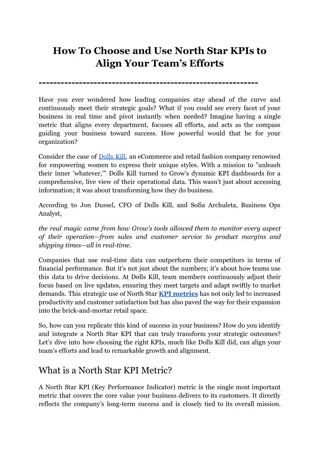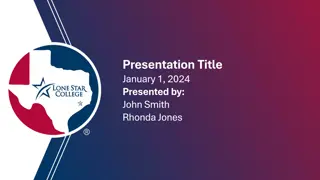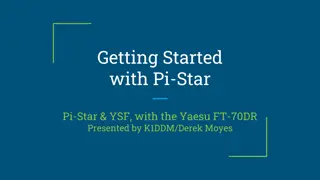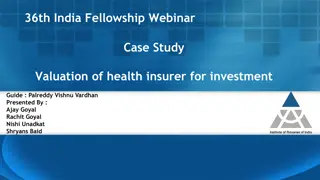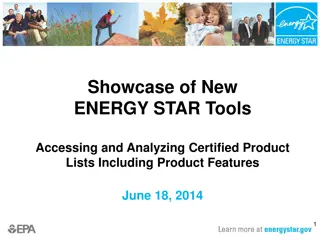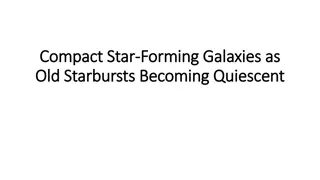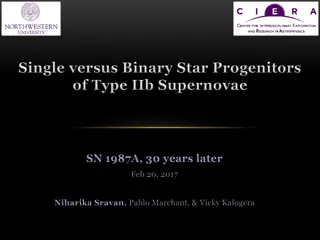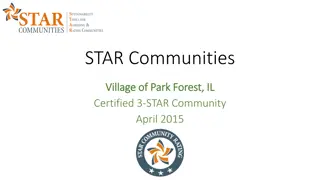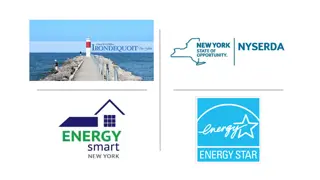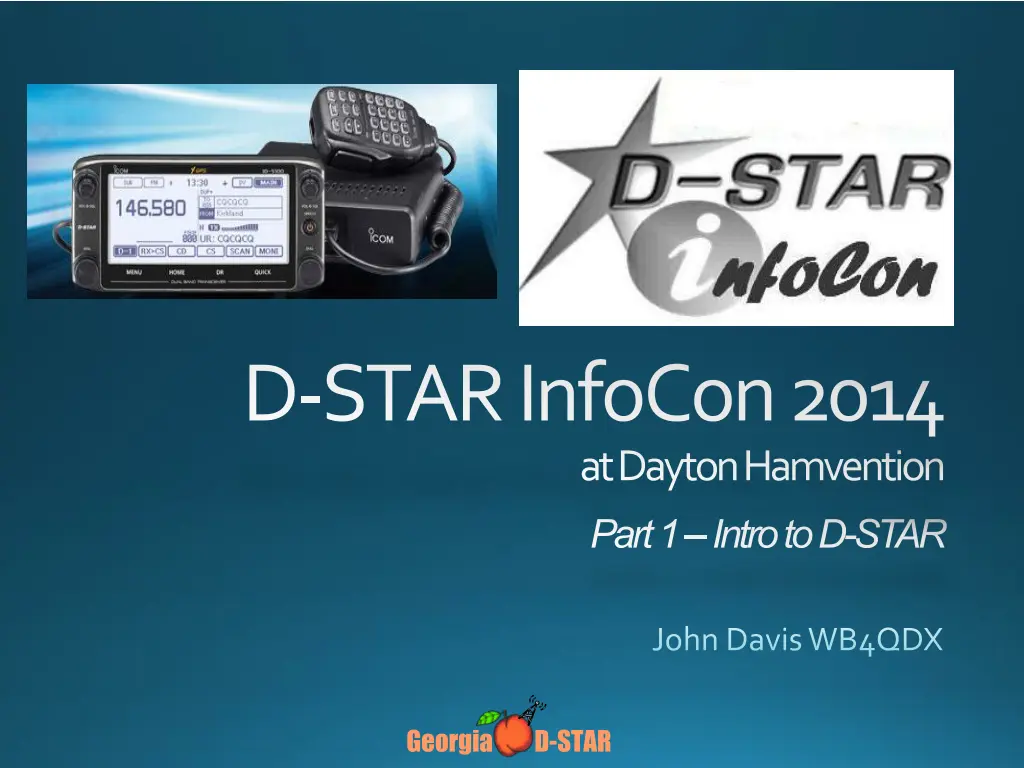
Introduction to D-STAR: A Look into Digital Voice and Data in Amateur Radio
Discover the world of D-STAR, an open standard for digital voice and data communication in Amateur Radio. Learn how D-STAR works, its capabilities, and the growth of this technology as of 2014. Explore the innovative features like simultaneous voice and data transmission, flexible repeater linking, and more. Join the thriving community of D-STAR users and repeaters worldwide.
Download Presentation

Please find below an Image/Link to download the presentation.
The content on the website is provided AS IS for your information and personal use only. It may not be sold, licensed, or shared on other websites without obtaining consent from the author. If you encounter any issues during the download, it is possible that the publisher has removed the file from their server.
You are allowed to download the files provided on this website for personal or commercial use, subject to the condition that they are used lawfully. All files are the property of their respective owners.
The content on the website is provided AS IS for your information and personal use only. It may not be sold, licensed, or shared on other websites without obtaining consent from the author.
E N D
Presentation Transcript
D-STAR InfoCon2014 at Dayton Hamvention Part 1 Intro to D-STAR John Davis WB4QDX D-STAR Georgia
What is D-STAR? D-STAR is an open standard for digital voice and data on Amateur Radio One of several digital modes in Amateur Radio Developed by Japan Amateur Radio League (JARL) Uses AMBE vocoder chip from DVSI Icom is first manufacturer with base, mobile, handhelds and repeater equipment Connect Systems planning D-STAR handheld for 2014 Other vendors offering other products 2 of 19 D-STAR Georgia
How does D-STAR work? Voice is converted to digital modulation and transmitted at 4800 bps 2400 bits for voice 1200 bits for Forward Error Correction on voice 1200 bits for data (error correction usually in applications True narrowband digital signal Voice and data occupy one 6.25 KHz signal (versus 12.5 KHz FM voice, P25 and MotoTRBO) Can operate simplex, repeater or linked to other repeater(s) 3 of 19 D-STAR Georgia
What can D-STAR Do? Transmit or receive voice and 1200 baud data simultaneously on 2m, 440 and 1.2 GHz (no TNC required) 128 Kb data transmission on 1.2 GHz with Internet connectivity (Ethernet bridge to Internet with IP address) D-PRS (digital APRS) automatic position reporting simultaneous with voice with GPS Flexible repeater linking with Gateway and Internet connection Reflectors act as conference bridge for linking multiple repeaters (60+ DPLUS Reflectors now in operation worldwide) DV Dongle, DV Access Point (DVAP) and DV Node Adapters allow voice and data access to D-STAR via Internet connection (similar to EchoLink) 4 of 19 D-STAR Georgia
D-STAR Growth Continues As of May 1, 2014 1,111 DPLUS Gateways, over 2,575 Voice Repeaters, 218 Data Modules and 34,298 registered users on US Trust Server and 62+ DPLUS reflectors in operation Other users, repeaters and reflectors on DCS and XREF systems Gateways Users Repeaters 2500 35000 1200 30000 1000 2000 25000 800 1500 20000 600 15000 1000 400 10000 500 200 5000 0 0 0 2007 2008 2009 2010 2011 2012 2013 2007200820092010201120122013 2007 2008 2009 2010 2011 2012 2013 D-STAR has largest base of users and repeaters of all digital modes 5 of 19 D-STAR Georgia
D-STAR Equipment D-STAR radios (mobiles, handhelds, repeaters) commercially produced by ICOM D-STAR handheld by Connect Systems available in late 2014 DV Dongle is non-radio device allowing access to repeaters and reflectors via Internet (similar to EchoLink) DV Access Point (DVAP) creates low power hotspot via Internet Node Adapters converts FM transceiver to D-STAR hotspot via Internet 6 of 19 D-STAR Georgia
Icom Radios Offers line of mobiles, handhelds and repeaters Most radios are dual band (2m, 70cm) ID-31A is 70cm only ID-1 is 23cm only, allows high speed data All radios operate standard FM and D-STAR digital modes All Icom radios have built-in serial port for data transmission All offer GPS as built-in, a part of speaker/mic or connection via serial or USB port 7 of 19 D-STAR Georgia
Icom Mobiles IC-2200 and ID-800 were initial mobiles D-STAR board can be added to IC-2200 ID-880 updated ID-800 with improved user functions Dual-band, single receive mobile IC-2820 is full featured mobile Dual-band, dual receive Built-in GPS with external antenna New ID-5100 mobile offers new features Dual-Band, dual receive GPS built into head unit Touchscreen display Optional Bluetooth interface DR Mode with 1200 included memories 8 of 19 D-STAR Georgia
Icom Handhelds IC-91AD was initial D-STAR handheld Dual-band, dual receive IC-92AD dual-band, dual receive Slightly larger frame with more heat sink Waterproof GPS spkr/mic optional accessory IC-80 introduced as lower cost handheld Dual-band, single receive GPS spkr/mic accessory available ID-31A is 70cm handheld Waterproof SD card for memory storage, update memory from downloads Built-in GPS User friendly DR Mode, locate closest repeater ID-51A is latest dual band handheld All features of ID-31A, but dual band, dual receive 9 of 19 D-STAR Georgia
ID-1 for 1.2 GHz Voice and Data Operates FM, Digital Voice (DV), low speed data and high speed data (DV) High speed data connection is Ethernet compatible Acts as Ethernet bridge 10 of 19 D-STAR Georgia
DV Dongle Produced by Internet Labs, available at major ham dealers Provides access to D-STAR repeaters via PC without radio Small module connects to PC via USB Uses PC sound card for mic/speaker audio Windows software runs efficiently on PCs, Netbooks, Windows tablet Coming to Android tablets, smartphones Java-based software for Mac, Linux Connect to repeaters, reflectors, send data, view history. 11 of 19
DV Access Point Produced by Internet Labs, available at major ham dealers Creates instant local access point for limited area without D-STAR repeater Connects to PC via USB Includes 10mw 2m transceiver and stubby antenna Use HT, other D-STAR radio nearby for full network access without local repeater Windows software module for configuration and operation 12 of 19
DV Node Adapters/GMSK Modems Provides D-STAR interface to FM radio Can be used to create hotspot or repeater Can create D-STAR compatible radio with Dongle 13 of 19 D-STAR Georgia
D-STAR Repeater Architecture Linux Gateway PC Running G2 Gateway software Runs third-party apps, Dongle, DVAP 14 of 19 D-STAR Georgia
The Registration Process Why register? Registering your callsign allows access to more functions (callsign routing, linking) Register on your local or the closest system Register on one and only one system (local registration syncs with all systems throughout world) Registration is a three-step process (all three steps must be completed) 15 of 19 D-STAR Georgia
Starting Registration Step 1 Browse to desired system and register as new user (https://callsign.dstargateway.org/Dstar.do) 16 16 of 19 D-STAR Georgia
Fill Out Your Info Fill out the info (callsign, name, email address and desired password) Step 2 System administrator must approve your initial registration. You may need to send email to admin. 17 of 19 D-STAR Georgia
Add a Terminal Step 3 Add at least one terminal with a space in first row under Initial, then type a pc-name (lower case, e.g. wb4qdx-dstar) Note: You only need one terminal, a space for use. Adding more terminals can add confusion 18 of 19 D-STAR Georgia
Add Your Callsign to Radio For a radio, program your callsign (caps, no spaces) in MYCALL or MY field Found in Menu under MY STATION in newer radios For a DVAP, DV Dongle or Hotspot, program call in callsign field exactly as entered in registration terminal Get on and talk! 19 of 19 D-STAR Georgia



![❤Book⚡[PDF]✔ Star Maps: History, Artistry, and Cartography (Springer Praxis Book](/thumb/21625/book-pdf-star-maps-history-artistry-and-cartography-springer-praxis-book.jpg)


